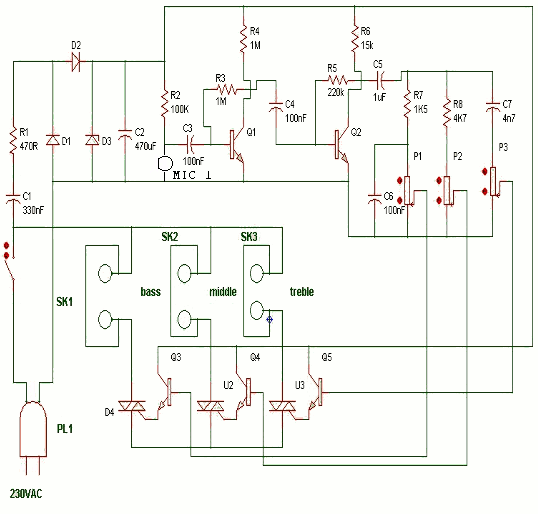Music/Sound Controlled Disco Light
The mains supply can be conveniently reduced with no heat dissipation by the reactance of C1; then rectified by D1 (1N4007) and D2 (1N4007) and clamped to 24V by the Zener Diode D3 (24V) due to the very low current consumption of this circuit. The built-in microphone pick-up the music diffused by the loudspeaker(s) of any type of media player and the two-stage transistor audio amplifier Q1(BC547) and Q2(BC547) amplify the resulting signal.
WARNING: Some parts in the circuit board are subjected to lethal potential because the device is connected to 230Vac. When plugged and enclose it in a plastic or wooden box, avoid touching the circuit. Avoid to connect this circuit to other appliances (e.g. to the output of an amplifier by means of a cable) due to the absence of a mains transformer. Please use only the microphone enclosed into the main case to pick-up the music.

The audio signal is filtered and split into three fully adjustable frequency bands by means of a simple (though effective) passive filter formed by P1(10k), P2(10k), P3(10k), R7, R8, C6 and C7 at the output of the second stage, thus avoiding the complexity of op-amp based active filters. The drivers for the Triacs D4(T1206M), D5(T1206M) and D6(T1206M) are transistors Q3(BC547), Q4(BC547) and Q5(BC547), but can be omitted if high sensitivity Triac devices are used.
C1 value must be doubled: use two 330nF capacitors wired in parallel or one 680nF 250V capacitor for 110-120V mains operation. No further modification is required. SW1 must be a high voltage, high current switch, as it must withstand the total amount of current drawn by all bulbs wired to the three outputs of the circuit. Using the suggested Triac type, each channel can drive several incandescent lamp bulbs, up to about 800W, but in this case a separate heatsink must be used for each Triac.